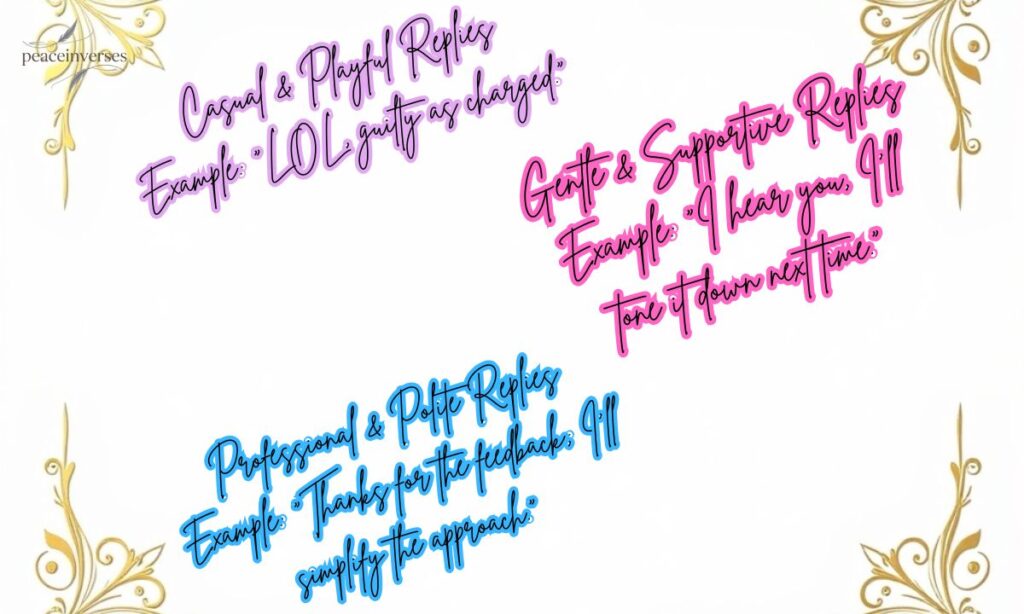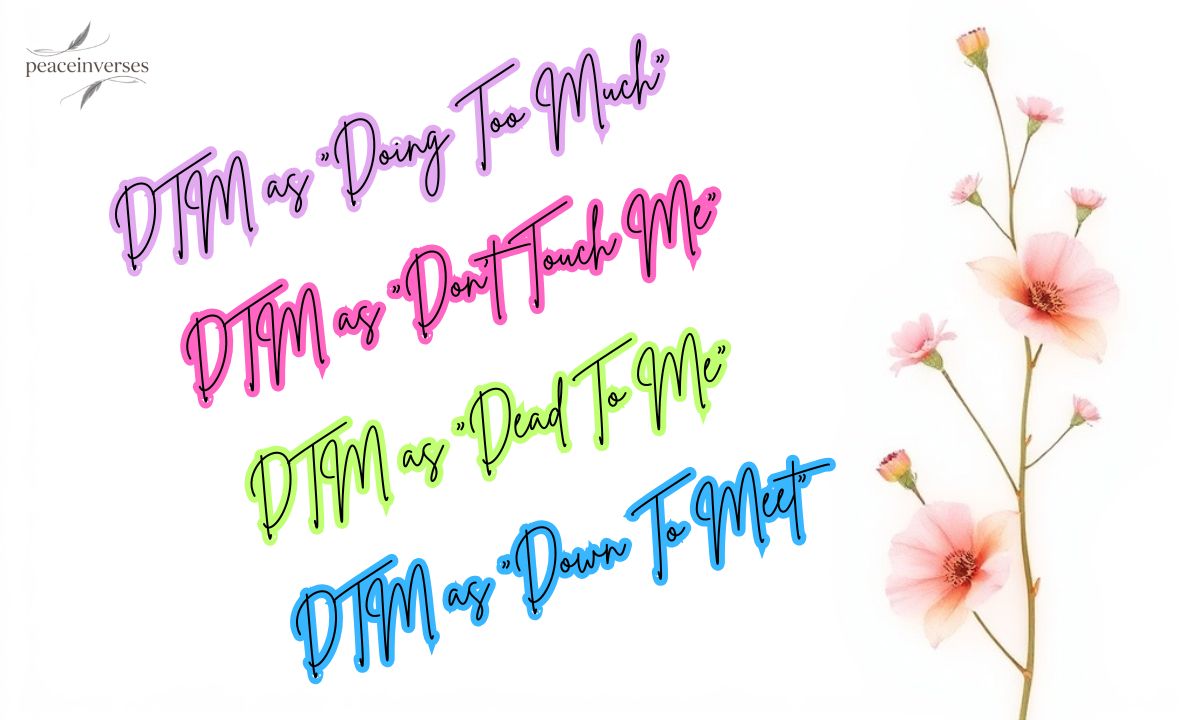Curious what DTM means in chats and posts? This quick guide explains the core meaning, common alternatives, and smart replies. Read on to use the term confidently and avoid tone traps.
Most of the time DTM stands for Doing Too Much and calls out over-the-top behavior. The same letters can mean very different things in other spaces, so context matters. Below you’ll find clear examples, polite swaps, and ready replies for every tone.
What Does DTM Mean in Text?
Most people use DTM to mean Doing Too Much when someone is acting extra or dramatic. It summarizes a behavior quickly and often with a teasing edge. In many chats it reads as light critique or playful ribbing. If the tone is sharp, it can feel rude rather than funny.
Different Meanings of DTM in Various Contexts
Acronyms shift meaning depending on platform, audience, and tone. Beyond Doing Too Much, DTM can mean Don’t Touch Me, Dead To Me, or rarely Down To Meet. In technical fields it often stands for Digital Terrain Model, which is unrelated to slang. Always check context before you react or reuse the term.
DTM as “Doing Too Much” (Most Common)
Doing Too Much labels behavior that seems excessive or theatrical. People tag posts, outfits, or gestures as DTM when the move feels over the top but not malicious. In friend groups it usually lands as a joke and signals playful critique. On public threads it can read critical or mean if not softened.
When you see DTM this way, ask whether the speaker is teasing or judging. If the tone is friendly, a playful reply is fine. If it feels harsh, consider a gentle or clarifying response. Understanding that social media favors punchy shorthand helps you interpret intent. Use context clues like emojis and prior messages to guide your reply.
DTM as “Don’t Touch Me”
Don’t Touch Me uses DTM as a quick boundary or a joking pushback. People say it when they want space or want to avoid drama in a light way. In texts it often comes with a playful emoji or an exasperated tone to soften the meaning. If the tone seems serious, treat it as a real boundary and step back.
Respect is the right first move when you get a DTM that reads like a boundary. A short reply such as “Okay, I got you” keeps things calm. Avoid pushing for details until they volunteer them. If the person later wants to talk, offer a listening ear. Boundaries are valid even when they arrive as slang.
DTM as “Dead To Me”
Dead To Me is strong and emotionally loaded; it signals serious hurt or a relationship split. People use it to indicate they want distance or that trust has broken. This version is not playful and usually requires repair work if reconciliation is possible. Reacting with sarcasm here will likely make things worse.
If someone tells you they feel DTM in this sense, slow down and acknowledge the hurt. Ask to talk when they are ready rather than argue over text. A short, calm acknowledgment preserves the possibility of repair. In many cases a face-to-face or voice conversation is the healthiest next step. Words matter more when the stakes are emotional.
DTM as “Down To Meet” (Rare Use)
Down To Meet shows up occasionally as a casual invite to hang out or meet up. It is less common than other meanings and can cause confusion if the group uses multiple senses of DTM. Because it is rare, clarify logistics when someone uses it for plans. Ask where and when rather than assuming.
When someone texts DTM meaning meet up, confirm details right away. Use clear time and place language to avoid misunderstandings. This prevents awkward back-and-forth or missed connections. Simple confirmation keeps plans smooth and safe. If you are unsure, a single clarifying question fixes everything.
DTM in Geography – Digital Terrain Model
In geography and GIS circles DTM stands for Digital Terrain Model, a technical depiction of land elevation. This meaning is domain-specific and appears in maps, surveys, and engineering reports. If you see DTM in a technical paper, assume it is not slang. Authors typically define acronyms on first use to avoid confusion.
For technical writing, spell out Digital Terrain Model the first time and use DTM thereafter. Include context like software names or data sources so readers can follow. In interdisciplinary work, clarify for non-technical readers. Mixing technical acronyms with slang risks misreadings in casual forums. Clear labeling avoids wasted time and miscommunication.
| Meaning | Context | Tone | Example | Best reply |
| Doing Too Much | Social media, texts | Playful or critical | “That outfit is so DTM.” | “Haha, guilty. I like it.” |
| Don’t Touch Me | Friends, quick boundary | Snarky or firm | “DTM, I need space.” | “Okay, I’ll give you time.” |
| Dead To Me | Arguments | Hurtful, final | “You’re DTM. We’re done.” | “I hear you. Can we talk later?” |
| Down To Meet | Casual invites (rare) | Neutral, logistical | “DTM tonight?” | “You mean meet up? What time?” |
| Digital Terrain Model | GIS, engineering | Technical | “Use the DTM for elevation.” | Spell out full term first. |
Is DTM Polite or Rude?
DTM is neutral on its own; tone makes it polite or rude. Among close friends it commonly feels playful and accepted. In workplace or formal settings it can seem dismissive or immature. Always consider who you are speaking to and the emotional stakes before using the acronym.
Professional Alternatives to “DTM”
In professional settings avoid shorthand and aim for clarity and respect. Use specific language that addresses behavior, not the person, and offer an actionable fix. This keeps feedback constructive and preserves working relationships. Below is a practical swap table you can use in emails and meetings.
| Casual phrase | Professional alternative | When to use |
| “That’s DTM” | “That approach may be a bit excessive.” | Peer review |
| “You’re being DTM” | “Could we simplify this for clarity?” | Project feedback |
| “This is DTM” | “This seems more elaborate than necessary.” | Design critique |
| “Stop being DTM” | “Let’s focus on the priorities.” | Team alignment |
Short tips: Replace labels with specific actions. State the impact briefly. Offer a clear next step.
Polite or Casual Alternatives to “DTM”
If you want to keep things light, use phrases that sound warm not cutting. Choose options that praise effort while hinting at excess. Soft language keeps relationships intact and still conveys your point. Use emojis in casual threads to signal a playful tone.
Helpful alternatives:
- “You’re going all out!”
- “That’s definitely extra.”
- “You’re bringing drama — and I love it.”
- “That’s a lot of energy today.”
- “Wow, you went full send on this.”
18 Polished Reply Examples for “DTM”

Ready replies save awkward moments and keep tone clear. Use a playful, supportive, or professional reply depending on the relationship and the stakes. Mix and match the examples below to match your voice. Keep replies short so they read well in chat.
Casual & Playful Replies
Here are fun, short responses that keep the mood light and friendly:
- LOL, guilty as charged.
- Okay okay, I’ll tone it down.
- DTM is my middle name.
- Tell me when I’m doing enough then.
- But it makes a wild story.
- I live for the drama, can’t help it.
Gentle & Supportive Replies
These replies show care and understanding without sounding defensive:
- I hear you, I’ll tone it down next time.
- Thanks for being honest; I didn’t realize.
- I just wanted it to feel special.
- I appreciate the nudge, I’ll balance it.
- Thanks — I’ll try a simpler approach.
- Got it, I’ll keep it more low-key.
Professional & Polite Replies
Use these replies to keep work conversations respectful and constructive:
- Thanks for the feedback; I’ll simplify the approach.
- I appreciate the note; I’ll focus on clarity.
- Understood; I’ll streamline the deliverable.
- I will revise and present a shorter version.
- Point taken; let’s align on priorities.
- I’ll review and adjust to keep it concise.
When to Use or Avoid “DTM”
Acronyms like DTM live or die by context and relationship. Use it with people who understand your humor and where stakes are low. Avoid it when the conversation affects reputation, work, or emotions. When in doubt, choose clarity.
✅ Use It When:
Use DTM in casual group chats or meme threads among friends who share the vibe. Add a laughing emoji to signal playfulness if you are unsure. Use it for theatrical posts, bold outfits, or dramatic reactions that are not personal attacks. Self-deprecating use of DTM is usually safe and funny. Keep it out of messages involving sensitive topics.
❌ Avoid It When:
Avoid DTM in emails, formal feedback, or when someone is clearly upset. Do not use it with people who do not know your tone or cultural cues. Skip it in contexts with power differences, like boss-to-employee messages. Refrain from using it in discussions about mental health or serious conflict. If you must criticize, use respectful, action-focused language.
Why Understanding Nuance Matters
Short acronyms carry big emotional weight because they remove tone and body language. Misreading a single shorthand can escalate conflict or cause embarrassment. Learning nuance helps you fit speech to space and audience and prevents avoidable misunderstandings. It also makes your messages more effective and kinder.
DTM in Pop Culture and Social Media
On platforms like TikTok and Instagram DTM often tags bold fashion, dramatic edits, or theatrical reactions. Creators use it to poke fun or to celebrate someone’s over-the-top energy. In memes it signals a shared cultural shorthand for extra behavior. Watch for context and audience before you reuse the tag.
How to Replace DTM in Specific Scenarios
Replacing DTM with clearer phrasing keeps your intent intact and your tone safe. Small wording shifts can move a message from insulting to useful. Pick alternatives that either praise effort or offer a clear improvement. Below are scenario-specific swaps that work in common situations.
🗨️ In Emails:
In emails do not use slang; state the issue and the fix. Start with a brief positive note, describe the concern in one sentence, and propose a clear change. Offer to help implement the change and close politely. This structure makes feedback actionable and respectful. It also reduces the chance of misread tone.
🗨️ In Group Chats:
Group chat language can be casual but avoid blanket labels in mixed groups. If you must tease, use shared jokes or self-deprecating lines instead. If someone takes offense, apologize quickly and move the discussion private. Use direct messages to resolve personal disagreements. That keeps group dynamics healthy.
🗨️ In Personal Conflicts:
In conflicts swap shorthand for feeling-focused language and a repair plan. Name the feeling, name the behavior that triggered it, and offer a path forward. Invite the other person to share their view when they are ready. Use phone or face-to-face when the subject is heavy; text rarely suffices. Clear language eases trust-building and repair.
DTM Meaning on Snapchat and TikTok
On Snapchat and TikTok DTM tends to mean Doing Too Much and appears in captions, comments, and quick replies. Creators often use it to label dramatic clips or attention-grabbing looks. The context on these apps skews playful and performative, so it often lands as humor. Still, public comments can sting if someone reads them as personal attacks.
Frequently Asked Questions
What does DTM mean in texting?
Most often Doing Too Much, check context for other meanings.
Is DTM rude?
It can be; tone and relationship decide the impact.
Can DTM mean Don’t Touch Me?
Yes, sometimes as a boundary or joke.
What’s a professional swap for DTM? “
This may be more elaborate than needed.”
Should I use DTM on social posts?
Use it for playful commentary, not for personal digs.
Conclusion
DTM is useful when your audience matches your tone and the stakes are low. When you need clarity, choose respectful, action-focused phrasing instead. Keep replies brief and match the relationship you have with the reader. With the examples and swaps above you can use the term without causing unnecessary friction.

